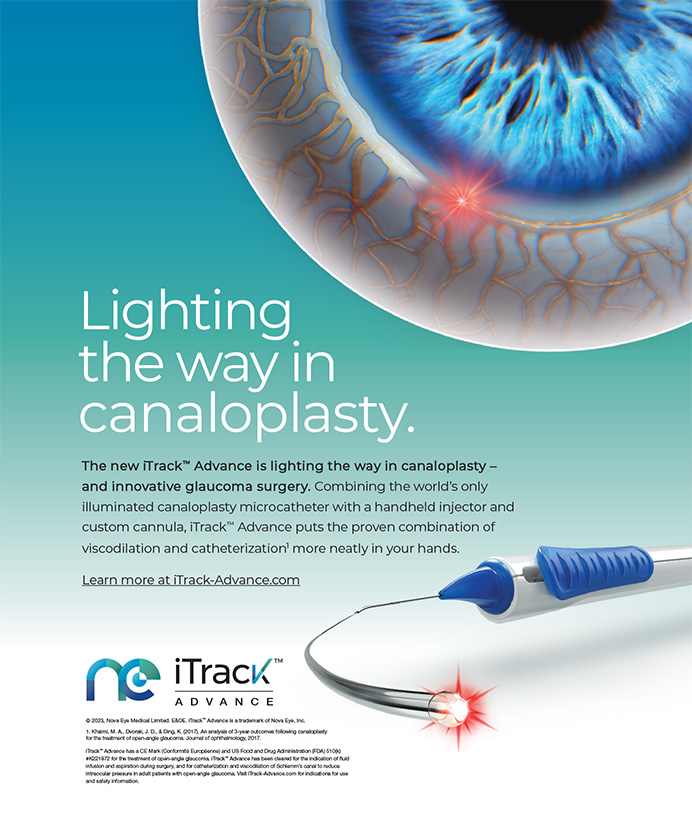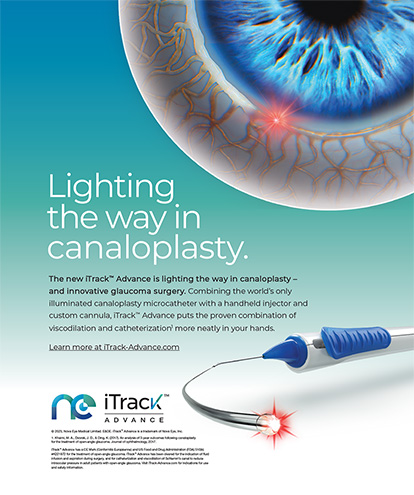What’s Driving the Shift to Lens-Based Refractive Surgery?
The answer is less simple than it appears.
By Lena Beckers, MD, and David Beckers, MD


The obvious answer to the question this article poses is patient desire for spectacle independence. If we dig deeper, however, it isn’t that simple.
A DESIRE FOR SPECTACLE INDEPENDENCE: THE PATIENT PERSPECTIVE
Patients’ everyday lives demand a range of functional vision because they are happening at all distances. They use near vision for reading, distance vision for driving and sports, and intermediate vision for viewing computers and smartphones.
Rapid technological advances during the past decade, both in and outside of medicine, have ratcheted up people’s expectations of what is possible. Breathtaking progress in cataract surgery has made it one of the most common procedures worldwide.
Patients' desire for spectacle independence has shifted the focus of cataract surgery more toward lens selection than the operation itself. These factors combined with advances in IOL technology and their advertisement, however, contribute to high expectations regarding the level of crisp, youthful vision that surgery can achieve and give patients the impression that anything is possible.
A SHIFT IN EYE CARE PROVIDER ATTITUDES: THE SURGEON PERSPECTIVE
A high standard of care is important to success with lens-based refractive correction. Criteria have been developed for evaluating the risks and benefits of surgery, and preoperative protocols have been established for IOL calculations and patient selection. Screening methods evaluate patient needs and personality traits,1,2 and their occupation, hobbies, and activities of daily living are considered.
Advances in small-incision cataract surgery have increased the procedure’s safety, efficacy, and efficiency.3,4 An advantage of a lens-based approach compared to laser vision correction (LVC) is that the former eliminates the patient’s future need for cataract surgery.
It is incumbent on eye care providers to offer an honest explanation of the potential benefits and limitations of surgery, the advantages and downsides of each IOL design, and the compromises in visual performance patients can experience after a lens-based refractive procedure. The risks of surgical intervention must be described in detail.
Potential sight-threatening complications such as retinal detachment after surgery have a higher incidence in young patients.5,6 Routine screening for vitreous detachment is required, especially in myopic patients because they are at increased risk of retinal detachment after refractive lens exchange (RLE).4 Myopic patients are also at greater risk of cystoid macular edema than hyperopic patients. In contrast, patients with hyperopia and a shallow anterior chamber are at increased risk of angle-closure glaucoma,7 which can make RLE an attractive option for these patient groups.
As both patients and surgeons are open to RLE, a comparison to alternatives is needed.
LASER VERSUS LENS-BASED REFRACTIVE SURGERY
Laser refractive surgery. Like lens-based refractive surgery, LVC has advanced in recent years. Algorithms have been developed for the treatment of presbyopia in addition to myopia and hyperopia. Advocates of this approach to presbyopia correction emphasize the advantages of cornea-based surgery and the risks of intraocular surgery such as capsular tears, cystoid macular edema, retinal detachment, and endophthalmitis. Yet, as with any surgery, presbyopic LVC has disadvantages.
No. 1: A reduction in quality of vision and uncorrected distance visual acuity. LVC induces higher-order aberrations, particularly in the hyperopic population, often resulting in lower uncorrected distance visual acuity (UDVA).2 RLE may be a better option for these patients.8
No. 2: Lack of reversibility. Most individuals in their 50s or 60s have healthy eyes without relevant comorbidities. If they develop diseases such as age-related macular degeneration or glaucoma, however, they may lose the visual performance necessary for success with a presbyopic laser treatment profile.
No. 3: Minimal overall knowledge of cataract surgery on patients who have undergone presbyopic LVC. IOL formulas and the devices used for preoperative testing have not been fine-tuned for these corneas yet, leading to less accurate refractive outcomes after cataract surgery.9
Lens-based refractive surgery. One option for lens-based presbyopia correction gaining popularity is to implant a monofocal IOL in the capsular bag and an add-on or piggyback lens in the sulcus. The partial reversibility of this approach offers an advantage over laser refractive surgery. The sulcus-fixated add-on IOL can be explanted while the monofocal IOL stays in place if a patient develops a comorbidity that negatively affects the visual performance of the trifocal optical system.10 Studies have found that the visual performance of two-lens systems can be similar to that of a multifocal IOL and may provide patients and surgeons with a sense of security about what the future holds.11-13
CONCLUSION
The desire for a full range of vision stokes patient demand for both lens-based and laser refractive surgery. Appropriate patient selection and education are integral to the success of either approach. Surgeons who treat presbyopia must set realistic expectations and be prepared to address refractive surprises. Patients should be informed preoperatively that neural adaptation can take 3 months or longer.14 Compared to LVC, a major advantage of RLE for a two-lens system is its partial reversibility.
1. Mester U, Vaterrodt T, Goes F, et al. Impact of personality characteristics on patient satisfaction after multifocal intraocular lens implantation: results from the “happy patient study.” J Refract Surg. 2014;30(10):674-678.
2. Balgos MJTD, Vargas V, Alió J. Correction of presbyopia: an integrated update for the practical surgeon. Taiwan J Ophthalmol. 2018;8(3):121-140.
3. Kaweri L, Wavikar C, James E, Pandit P, Bhuta N. Review of current status of refractive lens exchange and role of dysfunctional lens index as its new indication. Indian J Ophthalmol. 2020;68(12):2797.
4. Packard R. Refractive lens exchange for myopia: a new perspective? Curr Opin Ophthalmol. 2005;16(1):53-56.
5. Fernández-Vega L, Alfonso JF, Villacampa T. Clear lens extraction for the correction of high myopia. Ophthalmology. 2003;110(12):2349-2354.
6. Neuhann IM, Neuhann TF, Heimann H, Schmickler S, Gerl RH, Foerster MH. Retinal detachment after phacoemulsification in high myopia: analysis of 2356 cases. J Cataract Refract Surg. 2008;34(10):1644-1657.
7. Preetha R, Goel P, Patel N, et al. Clear lens extraction with intraocular lens implantation for hyperopia. J Cataract Refract Surg. 2003;29(5):895-899.
8. Ma L, Atchison DA, Albietz JM, Lenton LM, McLennan SG. Wavefront aberrations following laser in situ keratomileusis and refractive lens exchange for hypermetropia. J Refract Surg. 2004;20(4):307-316.
9. Pantanelli SM, Lin CC, Al-Mohtaseb Z, et al. Intraocular lens power calculation in eyes with previous excimer laser surgery for myopia: a report by the American Academy of Ophthalmology. Ophthalmology. 2021;128(5):781-792.
10. Khoramnia R, Yildirim TM, Son HS, Łabuz G, Mayer CS, Auffarth GU. Reversible Trifokalität durch das Duett-Verfahren. Ophthalmologe. 2020;117(10):999-1004.
11. Schrecker J, Feith A, Langenbucher A. Comparison of additional pseudophakic multifocal lenses and multifocal intraocular lens in the capsular bag. Br J Ophthalmol. 2014;98(7):915-919.
12. Schrecker J, Zoric K, Meßner A, Eppig T. Effect of interface reflection in pseudophakic eyes with an additional refractive intraocular lens. J Cataract Refract Surg. 2012;38(9):1650-1656.
13. Gerten G, Kermani O, Schmiedt K, Farvili E, Foerster A, Oberheide U. Dual intraocular lens implantation: monofocal lens in the bag and additional diffractive multifocal lens in the sulcus. J Cataract Refract Surg. 2009;35(12):2136-2143.
14. Alió JL, Pikkel J. Multifocal intraocular lenses: neuroadaptation. In: Alió JL, Pikkel J, eds. Multifocal Intraocular Lenses: the Art and the Practice. Springer; 2014:47-52.
A Broader Pool of Candidates for Refractive Lens Exchange
Technological advances allow younger patients to consider this option.
By Quentin B. Allen, MD

The number of patients coming to my practice interested in RLE has increased significantly during the past decade. This includes those seeking a LASIK evaluation but who are better suited for RLE. One reason is the dramatic improvement in presbyopia-correcting IOL technology, which has made lens-based refractive surgery an option for younger patients. These individuals are typically in their 50s when they begin to experience symptoms of presbyopia and some degree of dysfunctional lens syndrome.1
PATIENT EDUCATION
Counseling patients with presbyopia over the age of 50 years regarding vision correction involves explaining the limitations of addressing refractive error at the corneal plane, especially in the presence of progressive lenticular aberrations. LASIK offers mainly distance-only or monovision solutions in this population, and the effect may reduce as lens dysfunction worsens. If these patients want a more permanent solution after learning about the risks and benefits of lens-based procedures, they may be good candidates for RLE with a presbyopia-correcting IOL.
For RLE, I typically choose between an extended depth of focus (EDOF) IOL (Clareon Vivity, Alcon) and a diffractive trifocal IOL (Clareon PanOptix, Alcon). These lenses have met patient expectations most consistently, in my hands.
Preoperative discussions for RLE and cataract surgery at my practice are similar. Ideal candidates have some degree of hyperopia, and any astigmatism is regular. These individuals are accustomed to distance blur and a nearly full-time need for glasses or contact lenses. A thorough history is obtained that addresses their history of contact lens wear, including any experience with monovision and/or multifocality. Their motivation and desire for surgical intervention are also assessed.
PATIENT SELECTION
I tell appropriate candidates that two types of lenses can reduce or possibly eliminate their need for reading glasses. In several studies, four out of five patients with the PanOptix IOL never wore glasses after surgery.2,3 I emphasize the potential for visual phenomena such as glare and halos in low-light conditions, provide a visual representation, and answer any questions.
If concerns about visual disturbances arise, I discuss the option of an EDOF IOL. I explain that it functions like a bifocal lens, offering two zones of vision, either distance and intermediate or intermediate and near, depending on the focal target. EDOF IOLs offer excellent distance vision during the day and night with a low risk of visual disturbances such as glare or halos. If patients have monovision experience or are not suitable for a trifocal IOL owing to mild coexistent ocular pathology, I may suggest a mini-monovision approach to increase their range of vision and minimize their need for glasses at near.
If preoperative discussions and examinations confirm that a patient is suitable for RLE, they can then choose between an EDOF and a trifocal IOL. Those with monovision experience often choose the Vivity lens. Even patients without monovision experience who select a Vivity IOL typically tolerate a mini-monovision strategy if reasonable expectations are set preoperatively. A plano result is targeted in the first eye, and possible offset options (-0.50 to -0.75 D) for the second eye are discussed postoperatively.
Over the past 2 years, my RLE patients have been roughly evenly divided between EDOF and trifocal IOLs. Those who frequently drive at night and enjoy hobbies that require excellent distance vision typically choose the Vivity IOL and expect to wear glasses to read fine print. My colleagues and I evaluated patient satisfaction and spectacle independence after the implantation of various presbyopia-correcting IOLs and found that 33% who received the Vivity lens with a distance target never wore glasses, echoing my clinical experience.4
Some patients are candidates for a trifocal IOL in only one eye due to preexisting ocular pathology. In my experience, a mix-and-match approach with a Vivity in the eye with mild ocular pathology can be successful in this situation, but formal studies are warranted.
1. Waring GO, Rocha KM. Characterization of the dysfunctional lens syndrome and a review of the literature. Curr Ophthalmol Rep. 2018;6:249-255.
2. Hovanesian JA, Jones M, Allen Q. The PanOptix trifocal IOL vs the ReSTOR 2.5 Active Focus and ReSTOR 3.0-add multifocal lenses: a study of patient satisfaction, visual disturbances, and uncorrected visual performance. Clin Ophthalmol. 2021;15:983-990.
3. Zhu D, Ren S, Mills K, Hull J, Dhariwal M. Rate of complete spectacle independence with a trifocal intraocular lens: a systematic literature review and meta-analysis. Ophthalmol Ther. 2023;12(2):1157-1171.
4. Hovanesian JA, Jones M, Allen Q. The Vivity extended range of vision IOL vs the PanOptix trifocal, ReStor 2.5 Active Focus and ReStor 3.0 multifocal lenses: a comparison of patient satisfaction, visual disturbances, and spectacle independence. Clin Ophthalmol. 2022;16:145-152.
Adjustability is one Driving force of Earlier Adoption
Postoperative adjustability can increase patient confidence and thus procedural volume.
By T. Hunter Newsom, MD

RLE has become increasingly popular at my practice. Patients’ primary motivation is to reduce or eliminate their dependence on glasses and contact lenses and enjoy their daily activities without the hassle of visual aids. Some individuals, such as pilots, have professions that demand clear vision, and others choose to undergo RLE to enhance their career performance.
RLE is an option for some individuals who are not candidates for other vision correction procedures due to thin corneas or extreme refractive errors. As premium IOL technology has advanced, more of my patients have elected to undergo RLE at younger ages. They are usually in their 50s and presbyopic, have not yet developed cataracts, and are still working and/or have active lifestyles.
Of all the premium IOLs available, the Light Adjustable Lens (LAL; RxSight) is the biggest driver of my patients' adoption of RLE.
ADVANTAGES
The LAL’s refractive power can be adjusted postoperatively with a UV light treatment that modifies the implant’s curvature. The patient’s vision is assessed and fine-tuned over a series of weeks.
The LAL’s adjustability has substantially reduced refractive surprises after cataract surgery. A case series of 86 of my patients who received the LAL bilaterally found that 90% and 85% achieved UDVAs and uncorrected near visual acuities (UNVAs) of 20/20, respectively.1 The results give me confidence that I can satisfy high patient expectations.
The LAL can address a wide range of refractive errors, including myopia, hyperopia, astigmatism, and presbyopia. The lens is a versatile option for patients with complex vision needs. The LAL’s postoperative adjustability, moreover, obviates the need for an invasive surgical procedure to alter its power if a patient is unhappy with their initial vision outcome.
CANDIDACY
In my experience, the best candidates for RLE with the LAL have had stable refractive errors for at least 1 year and have healthy eyes with no ocular comorbidities. The preoperative consultation has determined that their specific needs can be addressed by RLE and that its benefits outweigh its risks.
1. Newsom TH. Premium custom blended vision with the RxSight Light Adjustable Lens. White paper. 2021.
A rising patient demand and surgeon enthusiasm are fueling growth
Exploring four treatment strategy scenarios.
By Tal Raviv, MD

In my practice, the increase in RLE volume is due to both my growing enthusiasm and rising patient demand for the procedure.
PRESENTING PATIENTS
Patients seek RLE in various ways. Initially, most came in wanting LASIK but were 45 to 60 years old and experiencing presbyopia. Recently, more patients have specifically requested RLE or custom lens replacement. This second group typically knows someone who recently underwent the procedure. A third group comprises spouses of my cataract patients who received a lifestyle presbyopia-correcting IOL. These spouses, envious of the spectacle-free vision achieved, don’t wish to wait until they develop cataracts.
RLE can be performed on a prepresbyopic eye, such as one with high hyperopia or myopia, but I generally reserve the procedure for patients with presbyopia. For younger individuals, I recommend other refractive modalities or postponing lens surgery.
FOUR CATEGORIES OF PATIENTS
I categorize the presbyopic RLE population into four groups.
No. 1: Plano presbyopia. These patients, generally between 43 and 55 years old, never wore glasses before developing presbyopia and are often challenging to satisfy. Most are intolerant of any residual refractive error. I typically recommend waiting for lens surgery unless they are already wearing one contact lens to induce myopia for monovision. In such cases, I consider a multifocal IOL such as the Tecnis Synergy (Johnson & Johnson Vision), which can provide consistent, crisp near vision while maintaining balanced distance visual acuity.
No. 2: Hyperopia. These are typically the easiest patients to please with RLE. They appreciate improvements in both UDVA and UNVA and tolerate small residual refractive errors well.
No. 3: Low myopia. This category can be broken down into two subgroups: those who read mostly without glasses and those who always wear them for reading, often owing to astigmatism. The second group is generally easy to please with a multifocal or EDOF IOL or a monovision strategy. For the former group, a solution that maintains that crisp near vision is critical—typically a multifocal lens in one or both eyes.
No. 4: High myopia. The risk of postoperative retinal detachment must be assessed. When one of these patients is interested in RLE, I consult a retina colleague to assess and treat the retinal periphery and determine whether a complete posterior vitreous detachment (PVD) is present. Studies have shown that the presence of a PVD almost eliminates the increased risk of retinal detachment due to high myopia.1,2 If a complete PVD is present bilaterally, I discuss RLE with the patient. Otherwise, I may recommend an EVO ICL (STAAR Surgical) or deferring RLE.
There are exceptions. For example, I might consider RLE for a patient with high myopia but no PVDs who has become intolerant of contact lenses. Patients can make an informed choice based on their circumstances.
TREATMENT STRATEGIES
Regardless of which of the four categories a patient falls into, there are two main strategies for achieving good UDVA, uncorrected intermediate visual acuity, and UNVA after RLE: a multifocal IOL or monovision. The decision between the two is often determined by several patient-specific factors, and sometimes a hybrid approach is used.
Scenario No. 1. For patients satisfied with contact lens or LASIK-induced monovision, I typically replicate the strategy using a monofocal plus IOL such as the Tecnis Eyhance (Johnson & Johnson Vision) or the LAL. After operating on the distance eye, I gauge the near vision obtained to decide on the offset for the nondominant eye.
Scenario No. 2. If a patient has monovision experience but became dissatisfied, and if they are a candidate for a multifocal IOL (ie, healthy retina and cornea), they receive a Tecnis Symfony OptiBlue EDOF IOL (Johnson & Johnson Vision) in the dominant eye and a Tecnis Synergy in the nondominant eye. This approach usually provides the vision balance they were missing with monovision as well as crisp vision in all three zones (and in between).
Scenario No. 3. For hyperopic patients desiring maximum spectacle independence, I consider bilateral implantation of a Clareon PanOptix or Tecnis Synergy IOL. If the patient requests what I term distant intermediate vision (> 24 inches such as for viewing a painting at a museum or a distant computer screen), I implant a Symfony OptiBlue in the dominant eye and a multifocal in the nondominant eye.
Scenario No. 4. For post-LASIK eyes, I prefer the Tecnis Symfony OptiBlue IOL, which tends to be forgiving of higher-order aberrations and astigmatism. Moreover, patients generally experience a significantly lower amount of nighttime dysphotopsias with the lens’ second-generation InteliLight features. The other option is the LAL, whose adjustability and some near-eye extended depth of focus are well suited to postrefractive surgery patients.
1. Qureshi MH, Steel DHW. Retinal detachment following cataract phacoemulsification—a review of the literature. Eye. 2020;34:616-631.
2. Daien V, Lepape A, Heve D, Carriere I, Villain M. Risks factors of retinal detachment following cataract surgery in a national population study between 2009 and 2012. Invest Ophthalmol Vis Sci. 2015;56:672.
achieving lasik-like outcomes after Cataract Surgery
Tips for maximizing patient satisfaction.
By P. Dee G. Stephenson, MD, FACS

Ophthalmology is a technology-driven field, and recently there has been increased patient interest in lens-based solutions for refractive errors. Younger patients with a history of refractive surgery who visit my practice for a cataract surgery evaluation have high expectations for achieving LASIK-like outcomes. They arrive armed with information from websites, referrals from friends, questions about outcomes and postoperative satisfaction, and requests for specific IOLs and techniques. This article shares my tips for success in this population.
PREOPERATIVE COUNSELING
I emphasize to patients that their visual recovery following cataract surgery will differ from that after refractive surgery. More healing time is required overall, and the recovery of one eye may differ from that of the other. I often say, “Your eyes are sisters, not identical twins.”
Comorbidities have a significant impact on a patient’s surgical journey. Ocular surface disease, regardless of its cause, must be diagnosed and managed before cataract surgery. The procedure may need to be postponed until an optimal surface is achieved. It is essential to inform patients if their ocular surface is compromised and to explain how this can affect surgical results. Failing to do so may lead them to believe that the surgery—or the ophthalmologist—caused their ocular surface disease.
IOL CONSIDERATIONS
Monofocal lenses. I prefer monofocal IOLs for patients with a history of refractive surgery. My go-to lenses are the preloaded monofocal and monofocal toric IOLs from Bausch + Lomb’s MX60E series. These IOLs are aspheric and tend to perform well in this patient population because they do not exacerbate corneal aberrations.
A monovision approach targeting -0.50 to -0.75 D of sphere in the nondominant eye typically increases patients’ depth of field and provides some near vision. In my experience, these IOLs center well, exhibit minimal rotation, and provide a stable refraction.
The consistent power distribution from center to edge in the MX60E series also works well for patients at increased risk of IOL dislocation due to pseudoexfoliation or other zonulopathies. The IOLs are available in a large range of dioptric and toric powers, which is advantageous for the correction of high astigmatism.
Small-aperture lenses. The Apthera IC-8 (Bausch + Lomb) serves as an excellent alternative for patients with a history of radial keratotomy, multiple refractive surgeries, or keratoconus. A postoperative refraction of -0.75 D of sphere is targeted.
The Apthera can mitigate the effects of presbyopia by extending depth of focus. Its pinhole effect can improve patients’ intermediate and near visual acuity without compromising their distance vision. Patients with keratoconus, in particular, seem to be highly satisfied with their outcomes.
CONCLUSION
Learning the pros, cons, and other important information about lens technology can help you be a better surgeon. Educating patients and guiding them toward the right decision increases their chances of achieving the best possible outcome. Take the time to answer their questions; a good referral will always follow you.




